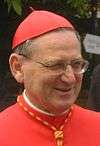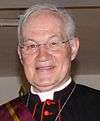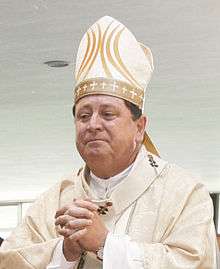Congregation (Roman Curia)
The second highest-ranking departments[1] of the Roman Curia (the central administration of the Catholic Church) are called congregations. Above them are the three Secretariats. Lower-ranking are the pontifical councils and pontifical commissions. Others are tribunals and offices.[2]
In origin, the congregations were selected groups of cardinals, not the whole College of Cardinals, commissioned to take care of some field of activity that concerned the Holy See. Today, as a result of a decision of the Second Vatican Council, the membership includes diocesan bishops from diverse parts of the world who are not cardinals. Each congregation also has a permanent staff to assist it in dealing with the business that comes before it.
Each congregation is led by a prefect, who is usually a cardinal.[3] Until recently, a non-cardinal appointed to head a congregation was styled pro-prefect until made a cardinal. This practice has been abandoned.
History and functioning
Certain curial departments have been organized by the Holy See at various times to assist it in the transaction of those affairs which canonical discipline and the individual interests of the faithful bring to Rome. Of these the most important are, without doubt, the Roman Congregations (Sacræ Cardinalium Congregationes), as is evident from the mere consideration of the dignity of their membership, comprising cardinals who are officially the chief collaborators of the pope in the administration of the affairs of the Universal Church, though Cardinals have not always participated in the administration of ecclesiastical affairs in the same way.[4]
Ecclesiastical business used to be handled by the pontifical chancery. However, the ever-growing number of business items and the ever-increasing complexity of the issues necessitated the creation of separate, specialised administrative-legislative bodies[3] (the administrative and legislative functions of ecclesiastical government are not as sharply separated in the Catholic Church as in a secular government with the separation of powers).[3]
The Roman Congregations originated in the necessity, felt from the beginning, of studying the questions submitted for pontifical decision, in order to sift the legal questions arising and to establish matters of fact duly. This work, at first entrusted to the papal chaplains, was afterwards divided between the penitentiarii and the auditores, according as questions of the internal or the external forum (i.e., jurisdiction) were to be considered. Thereafter, cardinals in greater or less number were associated with them. Often, however, they were not merely entrusted with the preparation of the case, but were given authority to decide it. As, on the other hand, the increased numbers of cases to be passed upon occupied a great number of persons, while the proper administration of justice required that those persons should be of the most experienced, it appeared to be advisable, if not necessary, to divide this business into various and distinct groups. This division would evidently facilitate the selection of wise and experienced men in all branches of ecclesiastical affairs. Hence also a natural division into executive cases, assigned to the offices (officia), judicial cases, reserved to the tribunals, and administrative cases, committed to the Roman Congregations.[4]
Pope Sixtus V was the first to distribute this administrative business among different congregations of cardinals; and in his Apostolic Constitution Immensa Aeterni Dei (22 January 1588) he generalized the idea, already conceived and partly reduced to practice by some of his predecessors, of committing one or another case or a group of cases to the examination, or to the decision, of several cardinals. By a judicious division of administrative matters, he established that permanent organization of these departments of the Curia, which since then have rendered such great services to the Church. The congregations at first established by Sixtus V were officially designated as[4]
- Congregation for the Holy Inquisition
- Congregation for the Signature of Grace
- Congregation for the Erection of Churches and Consistorial Provisions
- Congregation for the Abundance of Supplies and Prosperity of the Church's Temporal Dominions
- Congregation for Sacred Rites and Ceremonies
- Congregation for Equipping the Fleet and Maintaining It for the Defence of the Church's Dominions
- Congregation for an Index of Forbidden Books
- Congregation for the Execution and Interpretation of the Council of Trent
- Congregation for Relieving the Ills of the States of the Church
- for the University of the Roman study (or school)
- Congregation for Regulations of Religious Orders
- Congregation for Regulations of Bishops and Other Prelates
- Congregation for Taking Care of Roads, Bridges, and Waters
- Congregation for the Vatican Printing-Press
- Congregation for Regulations of the Affairs of the Church's Temporal Dominions
While the chief end of the Congregations of Cardinals was to assist the sovereign pontiff in the administration of the affairs of the Church, some of these congregations were created to assist in the administration of the temporal States of the Holy See. The number of these varied according to circumstances and the requirements of the moment; in the time of Cardinal De Luca there were about nineteen of them, as he tells in his "Relatio Romanæ Curiæ forensis", without counting other congregations of a lower order, consisting of prelates, as were, for example, the "Congregatio baronum et montium" and the "Congregatio computorum".[4]
Reform of Pius X
Other congregations were added by different popes, until a complete organization was established by Pope Pius X in his Constitution Sapienti Consilio of 29 June 1908, according to which there were thirteen congregations, counting that of the Propaganda as only one; however, the last-named congregation is divided into two parts: Congregation of the Propaganda for Affairs of the Latin Rite, and Congregation of the Propaganda for Affairs of the Oriental Rites, it may well be considered as two congregations, so that the total number of the congregations is fourteen. Sixtus V granted ordinary jurisdiction to each of the congregations which he instituted within the limits of the cases assigned to it, reserving to himself and to his successors the presidency of some of the more important congregations, such as the Congregation of the Holy Inquisition and that of the Signature of Grace. As time went on, the congregations of cardinals, which at first dealt exclusively with administrative matters, came to pass upon the legal points of the cases submitted to them, until the congregations overshadowed the ecclesiastical tribunals and even the Roman Rota, in fact almost taking their places. In time the transaction of business was impeded by the accumulation of jurisdictions, different congregations exercising jurisdiction rendering decisions and enacting laws in the same matters; Pius X resolved to define the competency of each congregation more precisely and to provide otherwise for the better exercise of its functions.[4]
On 29 June 1908, with the constitution Sapienti Consilio, Pope St. Pius X reduced the number of the congregations to 11.[3] They were:[3]
- Holy Office
- Consistorial Congregation
- Sacraments
- Council
- Religious
- Propaganda
- Rites
- Ceremonial
- Extraordinary Ecclesiastical Affairs
- Seminaries and Universities
- Eastern Church
All decisions of the sacred congregations require pontifical approval, unless special powers have been given previously by the pope. The officials of the congregations are divided into two classes: minor officers, who are to be chosen by competitive examination and named by a letter of the Cardinal-prefect, and major officers, freely selected by the pope, and named by a note of the Cardinal Secretary of State. There is to be henceforth no cumulation of offices in the hands of one individual, not only to satisfy the requirements of distributive justice, but also because the tenure of several offices by the same person often results in detriment to the service. Wherefore, it is forbidden for an officer of one of the congregations to serve in any way as an agent, or as a procurator or advocate, in his own department or in any other ecclesiastical tribunal.[4]
The competency of the 'congresso' in each congregation is determined. The congresso consists of the major officers under the presidency of the cardinal who presides over the congregation. It deals with the matters of less importance among those that are before the congregation, while those of greater moment must be referred to the full congregations of cardinals. It is also the business of the congresso to prepare for their discussion those matters that are to be considered by the full congregation. On the other hand, the congresso is charged with the execution of the orders of the full congregation that have received the approval of the pope. As examples of matters of greater importance which must be considered by the full congregation, the special rules (normæ peculiares) mention the solution of doubts or of questions that may arise in regard to the interpretation of ecclesiastical laws, the examination of important administrative controversies and kindred matters. The normæ peculiares and the normæ communes, together with the Constitution "Sapienti Consilio", constituted the entire code of Pius' organization of the Roman ecclesiastical departments.[4]
Following the Second Vatican Council, Pope Paul VI implemented many of the changes called for in the Curia with his Constitution Regimini Ecclesiae Universae of 15 August 1967. One of the main changes brought about by Paul VI was the admission of diocesan bishops and archbishops as members of the Congregations, which has previously been restricted to cardinals.
The most recent reorganization of the Roman Congregations came with Pope John Paul II's Constitution Pastor Bonus, issued June 28, 1988. This constitution more closely aligned the structure of the Curia with the norms established by the 1983 Code of Canon Law and the early drafts of what became the 1990 Code of Canons for the Eastern Churches. Pastor Bonus also continued Paul's expansion of the membership of congregations, allowing priests, deacons, the religious and the laity to be members of certain congregations and establishing consultors, experts appointed to the dicasteries of the Roman Curia to provide opinions, either singly or collectively, for particular issues when required.
Sr. Luzia Premoli, superior general of the Combonian Missionary Sisters, was appointed a member of the Congregation for the Evangelization of Peoples in 2014, thus becoming the first woman to be appointed a member of a Vatican congregation.[5]
Current congregations
See also
References
- ↑ Wooden, Cindy. "Changing needs, changing names: Reform of Curia is Vatican tradition". The Catholic Sun. The Catholic Sun. Retrieved 13 April 2017.
- ↑ The Roman Curia, index to departments
- 1 2 3 4 5 René Metz, Twentieth Century Encyclopedia of Catholicism, Vol. 80: What is Canon Law? (New York: Hawthorn Books, 1960), pp. 99-101
- 1 2 3 4 5 6 7 Catholic Encyclopedia, Roman Congregations
- ↑ http://www.ewtnnews.com/catholic-news/Vatican.php?id=10843
![]() This article incorporates text from a publication now in the public domain: Herbermann, Charles, ed. (1913). "article name needed". Catholic Encyclopedia. New York: Robert Appleton.
This article incorporates text from a publication now in the public domain: Herbermann, Charles, ed. (1913). "article name needed". Catholic Encyclopedia. New York: Robert Appleton.
External links
- The Roman Curia - Congregations
- The Roman Congregations - Catholic Encyclopedia article





